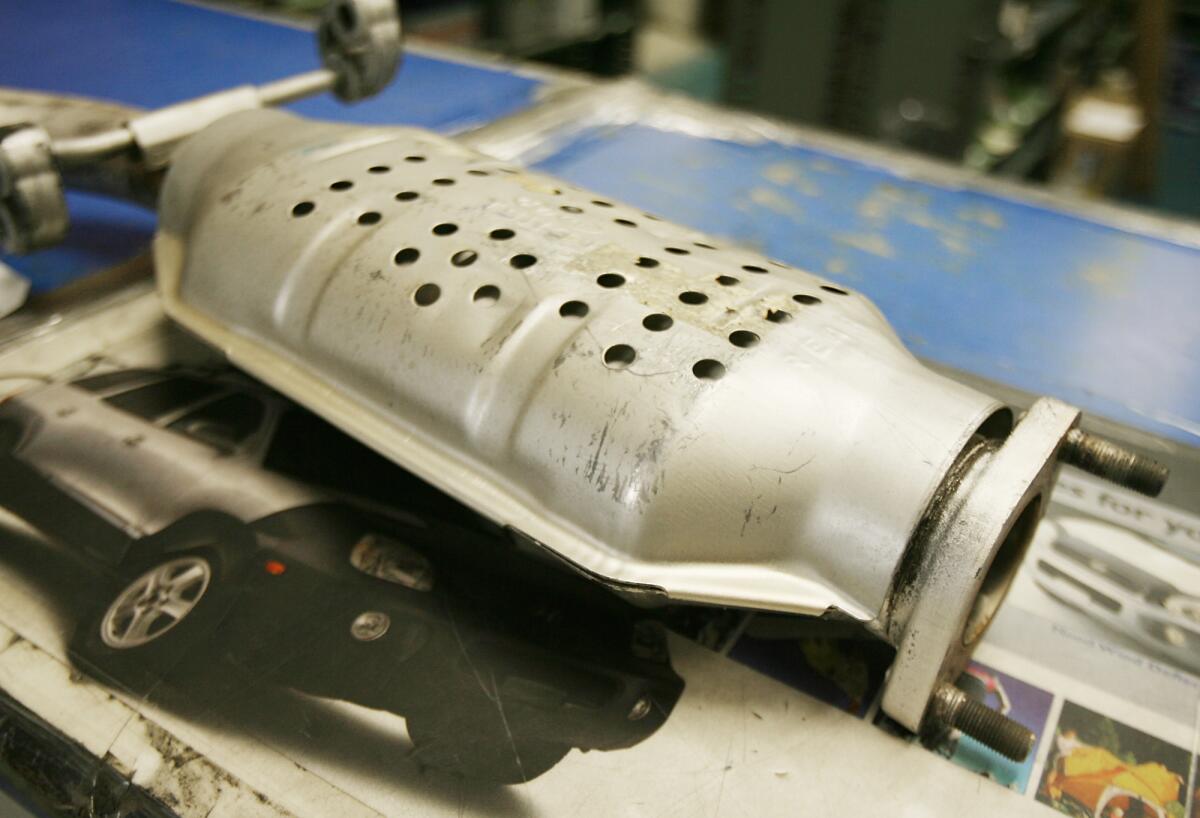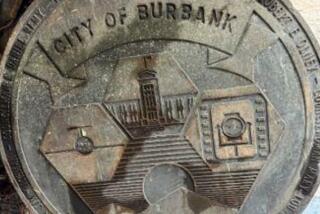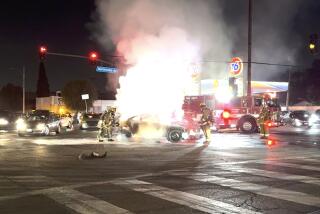Crackdown on thieves of catalytic converters nets 20 suspects in Torrance

A three-week crackdown on thieves who target catalytic converters has netted 20 people in Torrance, marking the latest round by law enforcement agencies to counter the burgeoning black market for the valuable car parts, police said.
Catalytic converters — devices which reduce emissions — generate large paydays for thieves because they are partially composed of expensive precious metals.
“The prices for the rhodium or palladium that are in it are so out of control right now,” said Sgt. Mark Ponegalek, a Torrance police spokesman. “The profit margin is too good for the crooks.”
In the recent operation, Torrance police began analyzing data on when and where reports of catalytic converter thefts were happening and sent out marked and unmarked police vehicles to patrol the neighborhoods at night, looking for vehicles driving slowly with lights off.
In 10 separate incidents over the past three weeks, Torrance police arrested 20 people suspected of stealing catalytic converters. All were suspected of grand theft and released with zero bail, according to Ponegalek. He would not comment on whether the no-bail releases are undermining the crackdown efforts. He did say that one of the arrested suspects was carrying in his pocket a citation related to other catalytic converter thefts.
“Catalytic converter thefts have been an ongoing concern for many years now,” said Alex Bastian, special advisor to Dist. Atty. George Gascón. “This office is currently engaged in formulating a long-term strategy to meaningfully combat and prevent these thefts from occurring.”
Ponegalek said information stemming from the 20 arrests led Torrance police Wednesday morning to a location in Los Angeles, where they recovered 87 stolen converters.
He said the thefts followed a typical routine: The thief drives into a residential neighborhood late at night with car lights off, then double parks alongside the victim’s vehicle. In a flash, they hop out, saw the catalytic converter off and quickly drive away — all in a matter of seconds. An informational Torrance police video from January shows security camera footage capturing a 45-second process.

This brief video provides an explanation of why catalytic converter theft is on the rise and what one can do to prevent it.
Hybrid vehicles such as Toyota Priuses are a favorite for thieves because they emit fewer toxins, leaving a cleaner and more valuable catalytic converter. Ponegalek noted that other frequently targeted vehicles include Honda Accords and pickup trucks, which can be easily vandalized without the use of a jack.
In Los Angeles County alone, the sheriff’s department reported a 400% increase in catalytic converter thefts from 2019 to 2020.
BeenVerified estimates there were 25,969 catalytic converter thefts nationwide from January through May — an 80% increase from the 14,433 reported stolen throughout 2020. By comparison, only 3,389 thefts were reported in all of 2019, BeenVerified reported, using statistics from the National Insurance Crime Bureau and Google search trends.
California was the hardest hit state for catalytic converter thefts in 2020, according to the report. In Los Angeles County, the Sheriff’s Department reported a 400% increase in catalytic converter thefts from 2019 to 2020. Torrance saw catalytic converter thefts increase 87% from January to June compared to the same period last year, according to Ponegalek.
The market for precious metals contained in catalytic converters — usually platinum, palladium and rhodium — has considerably tightened in recent years.
The increasing costs for the precious metals make catalytic converters an attractive choice for thieves — and a steep expense for car owners. Replacing a stolen catalytic converter can cost anywhere from hundreds of dollars to a few thousand, depending on a person’s insurance coverage. Many people have reported delays, too, since demand for replacements has created a backlog at many car dealerships and auto body shops.
Car owners can take steps to deter thefts by parking in protected garages, if possible, or in well-lit areas. Several companies sell cages to cover the catalytic converter, making them more difficult for would-be thieves to access.
Another common tactic is to imprint the vehicle identification number on the catalytic converter itself. If it is ever stolen and recovered, authorities may be able to trace it back to the original owner. Several law enforcement agencies hold etching events to help car owners ID their catalytic converters; Ponegalek said Torrance is hosting one in August.
More to Read
Sign up for Essential California
The most important California stories and recommendations in your inbox every morning.
You may occasionally receive promotional content from the Los Angeles Times.












